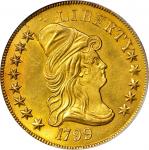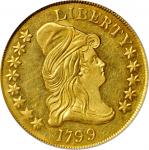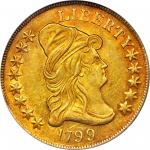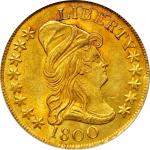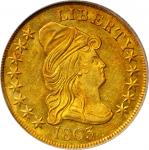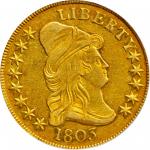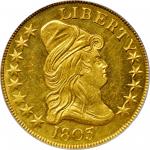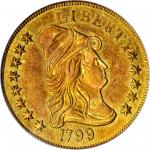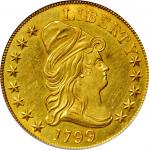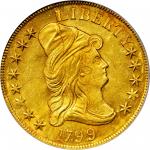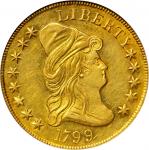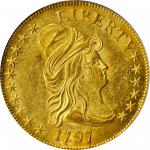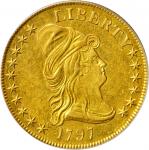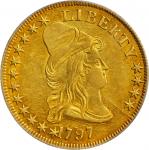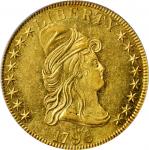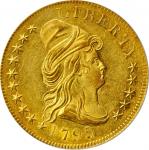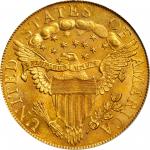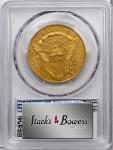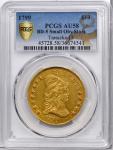1799 Capped Bust Right Eagle. BD-5, Taraszka-17. Rarity-6. Small Obverse Stars. AU-58 (PCGS).Type and Style: Type II: Capped Bust Right, Heraldic Eagle. Style VI: Head of 1795 with 13 small stars arranged eight left, five right; Reverse of 1799 with 13 small stars in the field below the clouds and a short, thick neck on the eagle. The head and eagle punches are attributed to hubs prepared by Robert Scot.Die Variety: BD-5, Taraszka-17, Breen 3-C, HBCC-3186. This variety represents the second of three uses of this obverse die and the only use of this reverse die. On the obverse, the digits 17 in the date are close and the second 9 is slightly higher than the first. Stars 2, 3 and 4 are lightly repunched, star 8 presents two points to the back of Libertys cap, star 9 lightly touches the letter Y in LIBERTY below the right serif, and star 13 is relatively distant from the end of Libertys bust. The reverse die is most readily attributable by the presence of a sizable rust lump or break at the bottom of the third clear stripe from the right, directly above the right edge of the eagles tail. Additionally, star 1 is lightly repunched, stars 9 and 10 are more closely spaced than any other adjacent pairs, and the letter O in OF is centered above a space between two clouds.Die State: BD Die State c/a. This is the only known die state of this variety. The obverse exhibits several cracks inherited from its use in the 1799 BD-4 pairing (Die State b): from the border through the top two points of star 8; an erratic rust-like crack from the field above the top of Libertys cap to the field between the letters LI in LIBERTY; from the border above the right edge of the letter L through the top of the letters IBERTY; from the border above the letter E to the right edge of its upright; between stars 9, 10 and 11. In this later die state, the cracks through star 8 and along the top of the letters ERTY are heavier with the crack through star 8 now extending into the back of Libertys cap. There are also new cracks: lightly from star 7 to the scarf below the back of the cap; from star 3 through Libertys lower hair curls into the back of the bust above the digits 17 in the date. The reverse die state is perfect with no clashing or lapping. The aforementioned die rust lump or break within the shield at the lower right is present on all known examples.Estimated Mintage for the Issue: The conventionally accepted mintage has been 37,449 coins for the 1799 Capped Bust Right eagle issue, based on Walter Breens assumption that all of the coins delivered between May 14, 1799, and September 4, 1800, were from 1799-dated dies. After careful study, Dannreuther provides a revised range of 31,750 to 46,250 pieces produced, the lower estimate allowing for the possibility that some 1797 BD-3 and/or BD-4 coins were included in Breens 37,499-piece mintage, and the upper estimate allowing for the possibility that some 1799-dated eagles were also included in later deliveries.Estimated Mintage for the Variety: Dannreuther estimates that 1,250 to 1,750 examples were coined from the 1799 BD-5 dies.Estimated Surviving Population for the Variety: Only 22 to 30 coins are believed extant in all grades (per Dannreuther).Strike: Virtually all design elements are sharply to fully rendered on both sides of this well struck early eagle. We do, however, note softness of detail to stars 1, 2, 3 and 12 on the obverse, at both of the eagles wing tips on the reverse, at the second cloud from the right on the same side, and at the two uppermost stars in the field above the eagles head. This same pattern of strike is seen on virtually all other 1799 BD-5 eagles with which we aware, including the Harry Bass Core Collection specimen.Surfaces: Handsome deep olive and orange-gold blends nicely over both sides. Subtle pinkish-red and powder blue highlights can be seen, especially on the reverse. The surfaces have a soft satin texture with only wispy handling marks that are easily overlooked. Equally faint are a few trivial adjustment marks on the reverse at the shield. A concentration of small, light marks in the lower obverse field before the date is mentioned solely for identification purposes.Commentary: As with all but two of the 10 known die marriages of the 1799 eagle, BD-5 is elusive and difficult to find under normal market conditions. Only a single die state is currently known, as related above, which is perhaps not surprising given the paucity of survivors. Since this reverse die was not used in any other pairing, some sort of terminal damage must have occurred to compel the Mint to retire the die. The most likely culprit is an expansion of the die break in the lower right portion of the shield, although this is just speculation. Perhaps terminal die state examples of this variety have all been lost since striking, or perhaps an example or two may remain unattributed in tightly held collections.This is only the fourth example of the 1799 BD-5 eagle that we have offered in recent years, a list that includes another AU-58, an AU-55 and an AU Details coin with a spot removed. All of those coins were also certified by PCGS at the time of our offering. The present example is attractive in all regards and would serve with distinction in any advanced gold cabinet.From the Anthony J. Taraszka Collection. Acquired from Anthony Terranova, December 2000. The plate coin for the die variety in the book United States Ten Dollar Gold Eagles: 1795-1804 by Anthony J. Taraszka.

